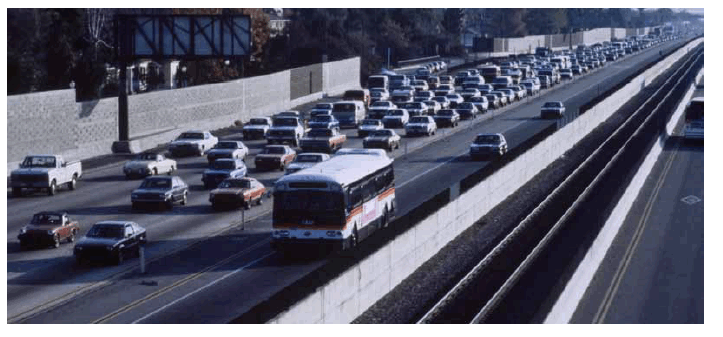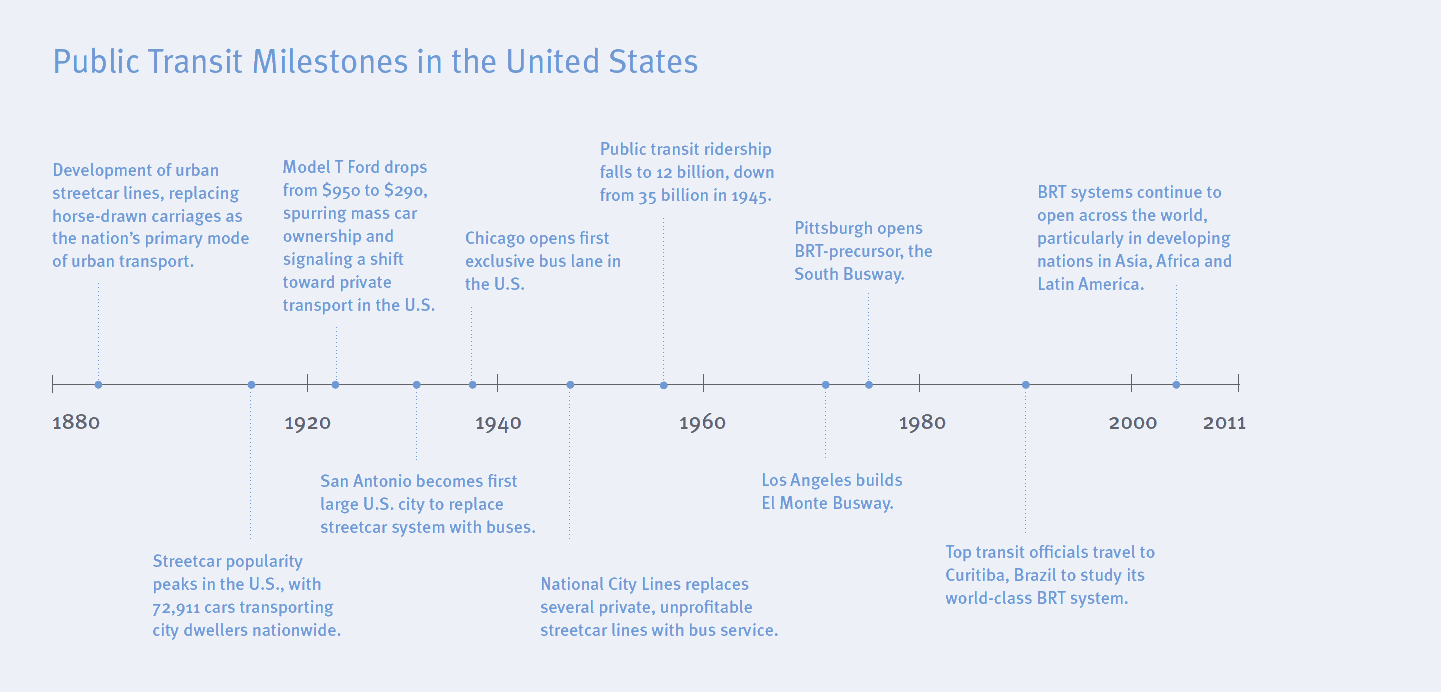INSTITUTE FOR TRANSPORTATION & DEVELOPMENT POLICY
Introduction
Bus Rapid Transit was first implemented in Curitiba, Brazil in 1974, and has become a global phenomenon in the twenty-first century. Major new BRT projects have opened since the turn of the century in Africa, Australia, China, India, Indonesia, Iran, Mexico, Turkey, several cities in Europe, and dozens of cities in Latin America.
BRT holds great promise for the United States. In 2008, transit ridership in the United States reached its highest level since the mid-1950s and ridership grew faster than population and vehicle miles travelled between 1995 and 2008 [ APTA 2010 Fact Book ]. The flexibility and cost effectiveness of Bus Rapid Transit make it an excellent choice for cities and transit agencies facing both increasing demand for transit and increasingly constrained budgets.
Though it is still in its infancy in the United States, several good BRT systems have opened in the country over the last decade, and perhaps a dozen new projects are in the pipeline in cities from San Francisco to Chicago. In many ways, the spread of BRT in the twenty-first century mimics the worldwide spread of the streetcar a century earlier.
Today, cities are beginning to realize that a good mass transit system helps attract an educated workforce that forms the backbone of the modern economy. A mass transit network is a powerful tool in the fight against traffic congestion, air pollution, rising road construction and maintenance costs, and the economic hazards of growing dependence on insecure and volatile oil imports. Cities that have already made the decision to invest in mass transit find BRT systems attractive for the following reasons:
- Speed of Implementation: the time from planning to opening tends to be far shorter for BRT than for rail-based alternatives — a benefit very attractive to politicians facing short election cycles.
- Cost: capital costs tend to be considerably lower than those for rail-based mass transit alternatives; operating costs are also lower in some contexts.
- Network Connectivity: because parts of the network can operate on normal streets, it is much cheaper and faster to establish a full network using bus-based mass transit. In this way, modern BRT can offer more one-seat rides than the typical trunk-and-feeder systems offered by older BRT and most light rail, metro, or commuter rail systems.
Rail-based mass transit technologies have certain common characteristics dictated by the need for rail infrastructure and the specialized vehicles needed to operate on it. This is less true for BRT systems, where there is no rigid definition of precisely what constitutes a BRT system. The lack of a common definition of BRT has caused confusion in discussions of the technology since its inception.
Lack of a common understanding of what constitutes a BRT system has led to branding problems. he lack of any sort of quality control on bus-based mass transit interventions has made it possible for marginal bus system improvements to be branded as BRT, leading to some community backlash against the concept of BRT. Modest incremental improvements, while beneficial to bus riders, are often not the most cost-effective solution. They certainly do not add up to the fundamental change needed to shift the travel paradigm in ways that make alternatives to driving cars attractive at a national scale.
This problem is by no means unique to the United States. After Curitiba opened the first BRT system, other cities in Brazil opened systems with some of the same characteristics as Curitiba, but with much lower speeds, capacities, and customer comforts. These light BRT systems — São Paulo’s passa rápido corridors, for example — also brought some real benefits to passengers, but were far less appreciated by the general public. As a result of this backlash, Brazil, once the leader in BRT system development, lags behind Colombia and other countries in BRT development. Instances of this same problem have occurred across the globe. After Indonesia opened TransJakarta — a system with significant problems of its own — other cities across Indonesia began opening copycat systems, the best of which brought about only marginal improvements, and the worst of which made conditions worse. Chinese and Indian cities, after gaining some limited familiarity with Bogotá’s TransMilenio, also made a number of sub-optimal bus system improvements, which were branded as BRT, but which could not be judged as cost effective.
The United States has followed a similar trend. Having gained some familiarity with BRT from visits to Curitiba or Bogotá, a number of American cities began developing BRT-type systems. Some of these systems have brought significant benefits and won public approval. However, even the best U.S. systems lack some key characteristics of the world’s best BRT systems, and none of them have fully captured the imagination of American motorists and voters.
Ultimately, the only true test of a high-quality mass transit intervention is an assessment of “cost effectiveness,” indicating:
- A substantial reduction in total travel time and/or travel cost for the population of transit riders in the project’s impact area;
- Evidence that the system has attracted new riders from other modes; and
- Effectiveness in achieving other public transportation objectives, such as serving as a framework for sustainable development. However, this indicator is heavily dependent on the first two.
Download full version (PDF): Recapturing Global Leadership in Bus Rapid Transit
About the Institute for Transportation & Development Policy
www.itdp.org
“The Institute for Transportation and Development Policy (ITDP) was founded in 1985 to promote environmentally sustainable and socially equitable transportation worldwide. We work with city governments and local advocacy groups to implement projects that reduce poverty, pollution, and oil dependence.”
Tags: BRT, Bus Rapid Transit, INSTITUTE FOR TRANSPORTATION & DEVELOPMENT POLICY, ITDP








 RSS Feed
RSS Feed